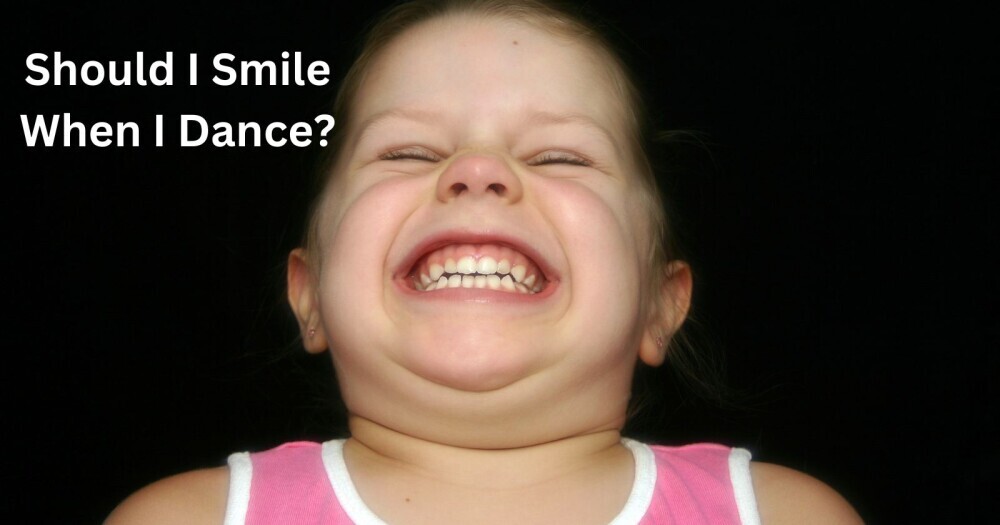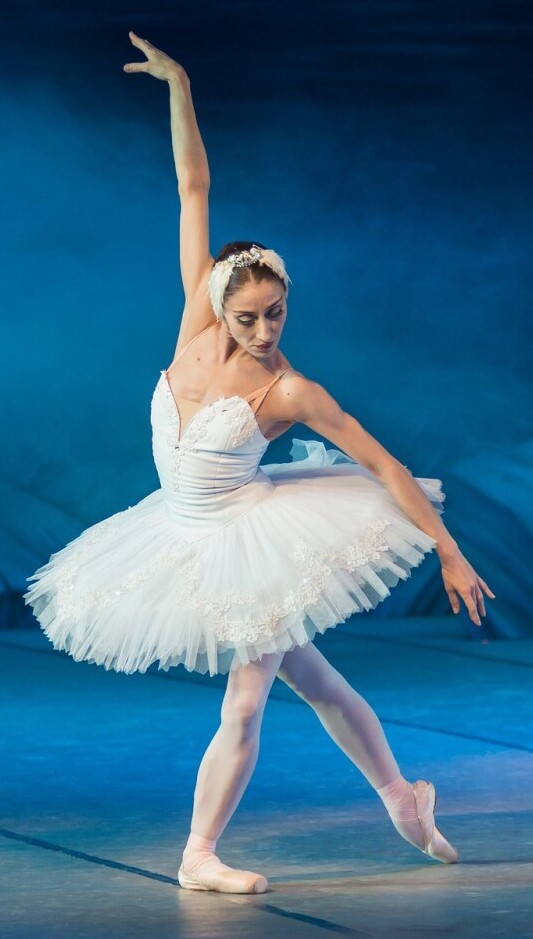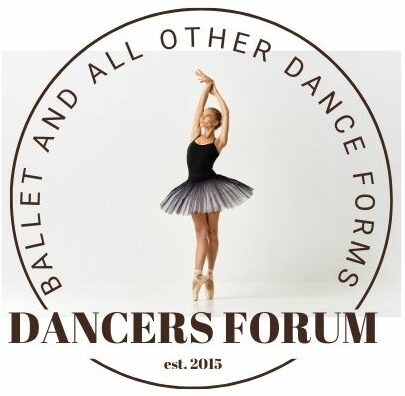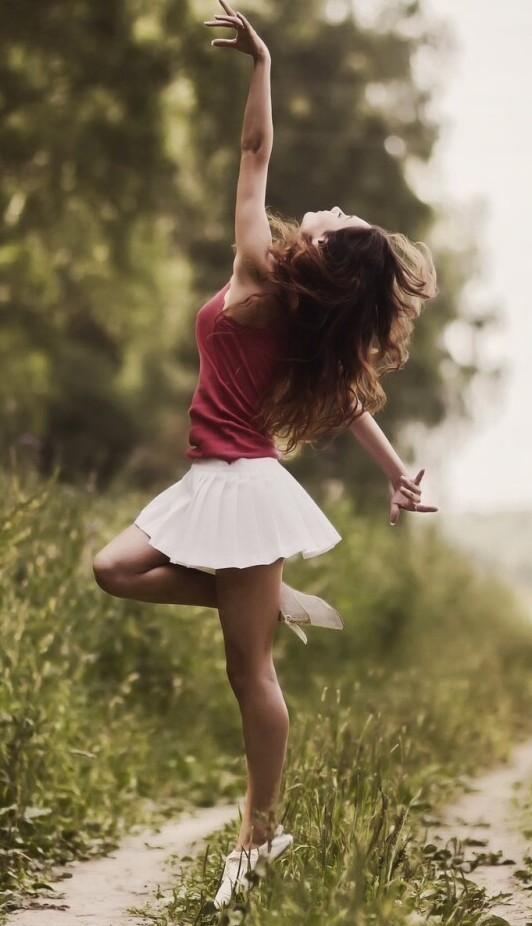As dance teachers, we are always telling our pupils to smile when they dance, but we do this to avoid those blank facial expressions you get when they are on stage. On the other side of the coin, you could end up with a cheesy smile with no change in the facials for the entire dance. But did you know that there is scientific evidence that smiling helps to reduce pain?
This article may have affiliate links, which means that the owner of this website will get a commission on qualifying purchases.

Should I Smile When I Dance?
Smiling goes beyond just lifting the corners of your mouth. There’s this awesome connection between your face and your brain that kicks in when you let out a grin. Scientists back it up, saying that smiles can do wonders, like cutting down pain and stress. How wild is that? When you smile, endorphins—your body’s natural painkillers—get rolling, making you feel all good inside.
Now think of smiling like a shield against stress. Those who are stressed bring on cortisol and adrenaline. A smile can bring those bad boys down a notch.
It’s not just all talk—there’s legit research showing that a cheerful grin can lower your blood pressure too. Imagine something as simple as a smile helping you live longer and reducing the risk of early death from serious stuff like cancer. That’s some next-level superpower!
But why does smiling have all this mojo? Well, when you’re genuinely smiling, specific muscles wake up, signaling your brain to pump out those feel-good chemicals. It’s like your body’s secret way of keeping you on the sunny side. And if someone, maybe a dance teacher, told you to “smile through the pain,” they were actually onto something. Smiling breaks down walls, both physically and emotionally.
So, next time you’re at a dance class or just living your everyday life, remember this little nugget: that smile on your face isn’t just decoration—it’s a full-body workout for your mental and physical well-being. As quirky as it sounds, your smile is your superpower—wear it proudly and let its magic unfold.
The Importance of Expression in Dance
Ok so as your students get older, they can use their smiles to help them cope, but they need to learn to control their facial expressions and think about what types of emotions they want to portray through their dancing.
Facial expressions play a crucial role in connecting with your audience. Dance isn’t just about perfect technique; it’s about storytelling, and your face is the narrator. When you flash a genuine smile or show intensity, you’re communicating right to the crowd’s heart. Those emotions invite them on the journey with you, making the performance memorable.
Ever heard of the ‘performance face’? Imagine it like conversing with a friend; your expressions are attentive and genuine, not forced or overly dramatic. It’s about having your eyes wide open, maintaining clear, focused eyes, and keeping your mouth slightly open with a relaxed jaw. This ‘aware’ expression keeps your audience engaged, making your performance come alive.
The best dancers know how to balance technique with emotional expression. Sure, you can nail a flawless pirouette, but the real challenge is to tug at the audience’s heartstrings continually. It’s what separates a good performance from a great one. Expressions add layers to your dance, turning steps into stories that resonate.
Facial expression is a skill like any other in dance—it can be mastered through practice. Incorporating acting exercises or improvisation sessions can enhance this skill. You’ll not only improve your performance but also your stage presence and confidence, making you the standout the judges can’t forget.
Individual Personality and Its Role on the Dance Floor

Think about what makes you unique as a dancer. Your personality isn’t just in your footwork—it’s in your expressions too. Finding that sweet spot where your style shines through elevates your dance to a whole new level.
Adding personality to your performances is like sprinkling a bit of magic. Maybe your smile is your spice, the extra kick that makes your rendition unforgettable. There’s nothing quite like seeing a dancer whose expressions are so genuine they light up the entire stage.
I once had a student, Gabi, who exemplified this. She was technically brilliant, but it was her infectious smile that glued audiences to her performance. Gabi’s expressions weren’t just part of her routine; they told her story. People remembered her not just for her skills but for how she made them feel.
Personal expressions can be your secret weapon in standing out, especially in auditions or competitions where judges see countless dancers. They’re looking for that spark, that something different that makes you memorable—your expressions can be it.
Practice with purpose. Work on expressing different emotions while dancing. Connect with the music and let that feeling translate to your expressions. It’s this authenticity that builds your stage presence and helps you leave a lasting impression.
Mastering the Art and Benefits of Smiling While Dancing
Incorporating a smile into your dance isn’t just about looking happy—it’s a full-on tool for enhancing your performance and personal growth. Teaching students how to bring this element into their routines helps them connect more deeply with both the audience and themselves.
Look at facial expressions like any dance move you’ve had to learn. Practicing in front of a mirror, experimenting with different looks, and taking acting or improvisation classes are excellent ways to develop this skill. The aim is to make these expressions second nature while dancing.
A smile can be a powerful aspect of your performance toolkit. It not only communicates joy but cultivates an approachable stage persona that draws people in, building a connection that’s palpable. Plus, let’s face it—smiling just makes you feel good, and that’s infectious.
Beyond the stage, smiling during a dance can help improve emotional intelligence and empathy, crucial skills for any artist. It allows for non-verbal communication that resonates with the audience and enhances the storytelling aspect of dance.
Here is a great book that can help you understand how your face communicates emotion. It is called Acting Face to Face.
So, keep smiling. This simple gesture can boost your mood, health, and how you relate to others on and off the dance floor. Your facial expressions have a ripple effect, making performances memorable and life better.
So I hope that I have answered your question of ‘should I smile when I dance.’


This article offers a compelling and insightful perspective on the significance of smiling in dance—not merely as a technique to enhance performance but as a powerful tool for improving both emotional and physical well-being. It delves into how a dancer’s facial expressions can influence not only their own experience but also the connection they establish with their audience.
One thought-provoking question that arises from this discussion is: How can dancers strike a balance between maintaining authenticity in their facial expressions and ensuring they don’t come across as forced or unnatural, particularly in performances that require a more serious, melancholic, or intense emotional tone? Given that different dance styles demand varying levels of expressiveness, are there specific training methods or exercises that can help dancers develop a genuine yet dynamic stage presence?
Additionally, could techniques from acting, mindfulness, or even psychology be integrated into dance training to help performers tap into emotions more naturally? It would be fascinating to explore how professional dancers approach this challenge and whether they use visualization, breathing techniques, or muscle memory to enhance their facial expressiveness without compromising the integrity of their performance.
Hi Herman and thanks for stopping by.
Interesting question.
As a dancer, we need to learn to interpret the music and the item we are dancing to and then feel what we need to do. Facial expressions should happen naturally as a result of how we are feeling, and not be too contrived. This is one of the most difficult elements to train as a dancer, as some people have a natural ability for this and others do not.
Thanks for this article on smiling while you dance. I love dancing, and was at a Valentine’s dance last night and found myself smiling quite a bit. I do believe that smiling and laughter relieve us of stress and are good for us. I also believe dance is a form of expression and I find my movements flowing naturally from the music. I also add personality to my dance so that my unique attributes shine through. I appreciate this most enlightening article on dance.
Thanks for taking the time to comment Joseph. Any sort of dancing helps to relieve stress as you proved at your Valentines dance.
I love watching people dance with abandon and expression and not caring what the world around them is thinking of them.